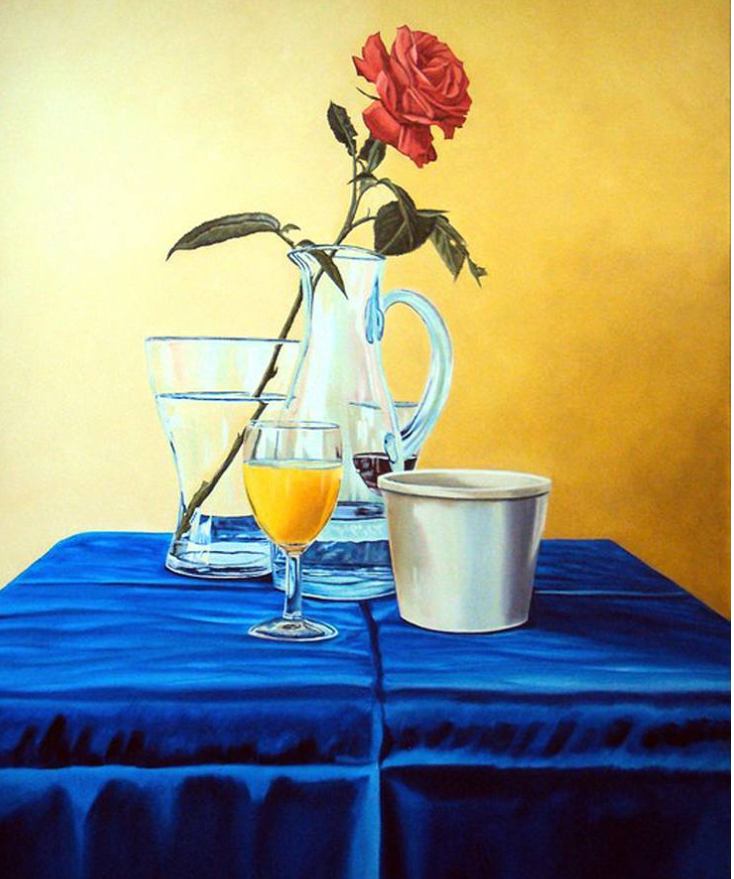Paolo Terdich’s Rosa 2, painted in 2010, is a still life masterpiece that transcends its genre through a striking interplay of light, texture, and emotional depth. This oil-on-canvas piece, which measures 19.7 inches by 27.6 inches, invites viewers to linger over its meticulous details and ponder its underlying themes. By transforming a simple subject—a red rose in a glass vase—into an evocative work of art, Terdich demonstrates his ability to elevate the ordinary into something extraordinary.
At first glance, Rosa 2 presents itself as a straightforward still life. A single red rose stands in a tall glass vase, accompanied by other objects—a ceramic pot, additional glassware, and a flowing blue cloth. The arrangement seems effortless, yet a closer inspection reveals its careful orchestration.
The rose is the undisputed focal point of the composition. Its vibrant red hue commands attention, drawing the viewer’s gaze upward toward its delicately rendered petals. The flower’s intricate detailing creates a sense of vitality and fragility, capturing the essence of life itself.
The surrounding objects play a crucial supporting role, providing balance and context. The ceramic pot, for example, anchors the scene with its solid presence, while the glassware introduces an element of transparency and reflection. The blue cloth, draped softly across the surface, adds a sense of movement and texture. Together, these elements create a harmonious tableau that feels both dynamic and serene.
The red of the rose is bold and commanding, symbolizing passion, love, and vitality. Its intensity is heightened by the more subdued tones of the surrounding elements, ensuring that it remains the centerpiece of the composition.
In contrast to the warmth of the rose, the blue cloth introduces a sense of calm and introspection. This cool hue acts as a counterbalance, tempering the rose’s fiery energy and creating a sense of equilibrium. The whites and transparent tones of the glassware further enhance this balance, lending an air of purity and clarity to the scene.
One of the most striking aspects of Rosa 2 is its masterful use of light and texture. These elements work together to create a sense of realism that is both tactile and luminous.
Terdich uses light to highlight the interplay between transparency and opacity. The glass vase, for instance, captures and refracts light, creating subtle reflections and distortions that add depth to the composition. Similarly, the folds of the blue cloth catch the light in a way that emphasizes its softness and fluidity.
The painting’s textures are rendered with incredible precision, from the velvety petals of the rose to the smooth surfaces of the ceramic and glassware. These contrasts invite viewers to imagine the tactile qualities of each object, enhancing their connection to the work.
The rose, long a symbol of love and beauty, takes on deeper significance in Terdich’s composition. Here, it represents the fleeting nature of life’s most cherished moments. Its vibrant color and delicate form remind us of the impermanence of beauty and the passage of time.
The glass vase, with its clean lines and transparency, symbolizes containment and clarity. It holds the rose in place, much like the structures and routines of daily life. Yet its reflective surfaces also suggest introspection, encouraging viewers to look beyond the surface and consider what lies within.
The blue cloth serves as a grounding element, providing stability and balance to the composition. Its soft folds and cool tones evoke a sense of serenity, offering a counterpoint to the rose’s fiery intensity. Symbolically, it represents the calm amidst life’s passions and struggles.
What sets Rosa 2 apart from other still-life paintings is its ability to evoke a wide range of emotions. Through its careful composition and symbolic depth, it invites viewers to reflect on their own experiences and emotions.
The painting’s central theme—beauty in the face of impermanence—resonates deeply with viewers. The rose’s vibrant color and fragile form serve as a reminder to cherish life’s fleeting moments, while the surrounding objects suggest the quiet constancy of the everyday.
Despite its emotional depth, Rosa 2 exudes a sense of calm and serenity. Its harmonious composition and balanced color palette create a soothing atmosphere, making it a work that viewers can return to again and again for comfort and inspiration.
Paolo Terdich is known for his ability to infuse everyday objects with profound meaning, and Rosa 2 is a shining example of this talent. His work reflects a deep understanding of the still-life tradition, while also pushing its boundaries to explore new emotional and symbolic dimensions.
Born in Piacenza, Italy, Terdich has lived and worked in various countries, enriching his artistic vision with diverse cultural influences. This global perspective is evident in Rosa 2, which combines the classical elegance of Italian still-life painting with a modern sensitivity to light and texture.
Terdich’s goal, as he has stated, is to “penetrate the inner world of emotions.” Through his meticulous attention to detail and nuanced use of color, he succeeds in creating works that resonate on both visual and emotional levels.
Paolo Terdich’s Rosa 2 is a testament to the power of art to transform the ordinary into the extraordinary. Through its masterful composition, rich symbolism, and emotional depth, it invites viewers to see a simple rose in a new light.
More than just a still life, Rosa 2 is a meditation on beauty, impermanence, and the quiet moments that give life meaning. It stands as a shining example of Terdich’s artistry and a timeless piece that continues to inspire and captivate audiences worldwide. Whether displayed in a gallery or a private collection, Rosa 2 is a work that will undoubtedly endure for generations to come.
No comments yet.








